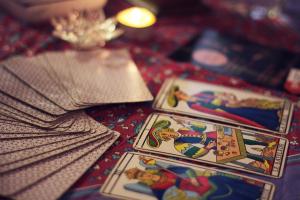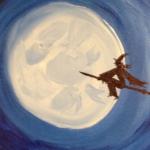 I want to share with you a recent discovery of a new approach to reading Tarot that has been giving me some good results. But first, I have to tell you about my favorite podcast.
I want to share with you a recent discovery of a new approach to reading Tarot that has been giving me some good results. But first, I have to tell you about my favorite podcast.
Harry Potter and the Sacred Text
The podcast is Harry Potter and the Sacred Text. I mean, seriously, if you haven’t listened to this podcast and are even a casual fan of the Harry Potter series, go check it out. The hosts, Vanessa Zoltan and Casper ter Kuile read the Harry Potter canon as a sacred text, taking one chapter at a time, reading it through the lens of a particular theme, and then using one of the spiritual practices coming from either the Jewish or the Christian tradition to dive more deeply into the text. Although almost everyone I’ve told about this podcast has laughed when I’ve said that they are reading Harry Potteras sacred text, they are actually approaching it with depth and intention and although it can be lighthearted at times, it’s a serious project with some beautiful results. (Go listen! http://www.harrypottersacredtext.com/)
Okay, so, why am I telling you all this in a post about Tarot reading? Here’s why. I’ve never been a great Tarot reader. I think that’s partly because I’ve been using a deck that doesn’t resonate as deeply with me as would be helpful. And also because reading a spread of even three cards gets me completely lost in the weeds. There are things that enliven my intuition or subconscious mind, but I’ve struggled to get that to happen with Tarot cards. Until…
Lectio Divina
One day it occurred to me to try a particular practice from Harry Potter and the Sacred Textand apply it to Tarot reading. The practice is Lectio Divina, which is Latin for sacred reading, and is an ancient Christian approach to biblical interpretation and inspiration. In this case, by interpretation, I don’t mean a scholarly approach to the text, but rather a personal spiritual approach that seeks wisdom and guidance from a very short bit of text – one word or one verse, often chosen at random. As such, one way to look at Lectio Divina is as a form of divination – a search for divine guidance through a particular bit of something. Hmmm… what does that remind me of? So, like I said, one day it occurred to me that one could try “reading” a Tarot spread with this same practice.
I’ve actually learned several different ways of doing Lectio Divina, but as Vanessa and Casper do it, after the text is chosen, and they do usually do that by putting their finger on a random sentence, they apply a four step process to dive into it. Here are the steps:
- What does this sentence literally mean, and what is its literal context? In other words, what is actually happening in the story at the point of this sentence.
- What symbols or stories does the text reference or suggest? These might be things that are clearly intended in the text, but it also includes the reader’s own intuitive associations to symbols, stories, other texts, etc.
- What does this remind you of in your own experience? Either the text itself or the symbols/stories/etc. that you’ve thought of in step 2.
- Finally, what do you feel called to do as a result of this study of the text? Traditionally, what is God calling you to do through this passage?
Applying this to Tarot reading was an interesting exercise in translation. But I was actually surprised by how well it works. Here’s my slight alteration of the steps to images rather than words. Thinking of a question or situation on which you would like some insight, shuffle the deck and draw one card.
- What do you see? Like, literally. What is in the picture? Describe it in detail. Also notice what you notice first, second, third, etc. What did it take you a moment to see?
- What symbols/stories are suggested in the image? What are the symbolic meanings of the actual elements of the picture? (For example, if there’s an egg in the image, what do eggs symbolize?) Also, what other symbols or stories or ideas does the card suggest to you?
- What does this remind you of in your own experience? Does the card seem to speak to an experience you’ve had in the past? (This is more helpful, I think, than to think about ways you are feeling this way now – the connection to other moments in your life is a way of accessing wisdom about how you did well last time or what you might want to do differently.)
- What do you feel called to do as a result of the first three steps? Or what action is the card suggesting? (Depending on how you posed the question, this is probably the “answer,” though the whole process will hopefully lead to insights.)
When I started playing with this, I did it with 3-card spreads, and quickly discovered that this is just too much information to hold in your head about 3 cards at once. Just the process of literally describing 3 cards in detail takes a very long time, and was frustrating to me. But when I tried it with just 1 card, wow! I was amazed at how well it worked to help me focus my mind, gain insight and guidance, and have a clear answer about what to do next.
Here is a slight variation I’ve tried a few times lately. Sometimes when I get to the part about what I am called to do, I have a more specific question. So, lately I have drawn a second card for clarity about a single, focused question at the end. Rather than consider it at length, I draw the second card and write down the very first impression it gives me. Like: first thing that comes to your mind – turn the card – go! This has led to some very helpful further insights on the question of next steps.
This synthesis of spiritual practices has been very fruitful for me. I wonder what else we might discover if we put different practices in conversation like this. An exciting thought!

















